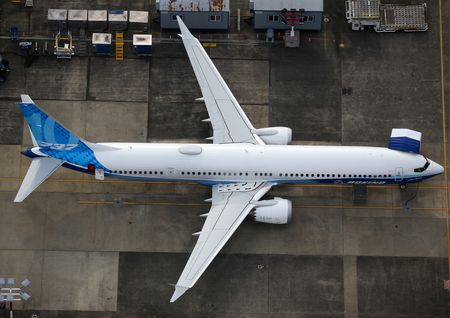
By Eric M. Johnson and David Shepardson
EVERETT, Wash./WASHINGTON (Reuters) -Boeing Co on Wednesday said it was making progress with regulators on its 737 MAX 10 aircraft but declined to offer a clear timeline on when it expects to win approval, in a tougher regulatory climate.
Boeing has a December deadline to win approval for the 737 MAX 10 – the largest member of its best-selling single-aisle airplane family. Otherwise, it must meet new cockpit alerting requirements under a 2020 law, unless Congress waves it.
The deadline for changes was introduced as part of broader regulatory reforms at the Federal Aviation Administration after fatal 737 MAX crashes in 2018 and 2019.
“We really need to complete a good proportion of the development assurance work,” Mike Fleming, a senior vice president at Boeing Commercial Airplanes, told reporters.
“It’s taking longer to get approval of our documents than it has in the past.”
Both the FAA and Boeing are working through a process that is different from what Boeing has done in the past, making it a challenge, said Fleming. The regulators control the timeframe and it is incumbent on Boeing to deliver on the elements of the certification plan, he said. As an example, Fleming said the FAA has taken ownership of certifying Boeing safety assessments that deal with how pilots interact with systems known as “human factors,” instead of delegating the work to Boeing’s own engineers as done in the past.
Fleming added that Boeing has brought on hundreds of engineers to work on certification, given the new climate.
In March, the FAA warned Boeing it may not win certification of the MAX 10 by the end of the year and asked the company to provide a “mature certification schedule.”
Sources briefed on the matter told Reuters it is not certain Boeing has enough time to win approval by December.
“Safety dictates the timeline of certification projects,” an FAA spokesperson said. “We cannot discuss ongoing certification projects.”
Missing the deadline for the 737 MAX 10 could require Boeing to revamp the jet’s crew alerting system and institute separate pilot training, which would raise costs to airlines and put orders at risk.
Unlike other Boeing aircraft, the 737 lacks the Engine Indicating and Crew Alerting System known as EICAS, which complies with the FAA regulation.
Boeing has grappled with festering industrial and certification issues across its jetliner portfolio, magnified by supply chain disruptions fueled by labor and parts shortages.
At a later briefing, Boeing marketing executive Darren Hulst acknowledged a narrowbody sales gap with rival Airbus SE, but expressed confidence the 737 MAX 10 and smaller variants would serve the core of the medium-haul market. Airbus’ A321XLR serves a fraction of the market, Hulst added.
“While it’s not an insignificant part of the market, we don’t think it’s even half of the market demand going forward,” Hulst said.
Asked about Boeing’s next airplane product, Hulst said it was an “open question” on whether a large narrowbody or small twin-aisle would best address Airbus’ advantage, adding the decision was wrapped up technology and market shifts.
Boeing Chief Executive Dave Calhoun told a conference earlier this month it would be “at least a couple of years” before digital manufacturing tools were mature enough to support a new aircraft program.
(Reporting by Eric M. Johnson in Everett; writing by David Shepardson in Washington; editing by Chris Reese, Deepa Babington and David Gregorio)

